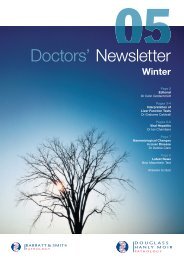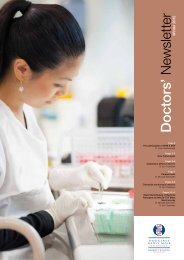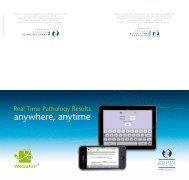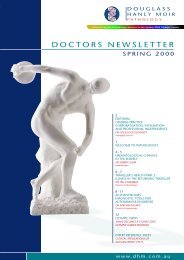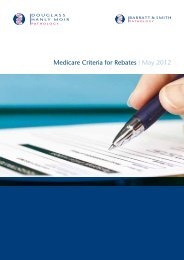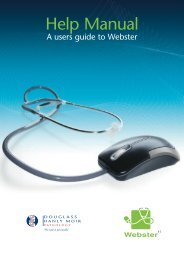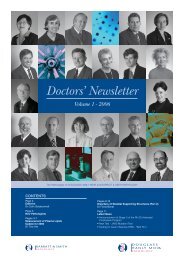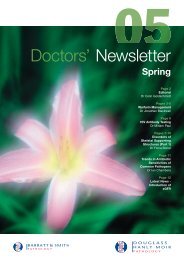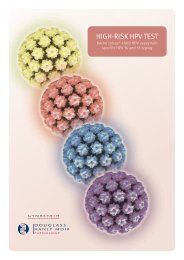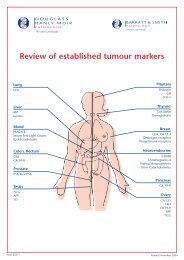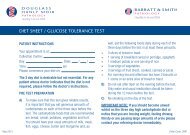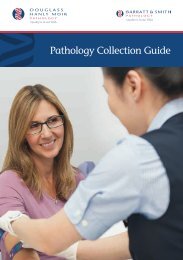Doctors' Newsletter - Autumn 2008 - Douglass Hanly Moir Pathology
Doctors' Newsletter - Autumn 2008 - Douglass Hanly Moir Pathology
Doctors' Newsletter - Autumn 2008 - Douglass Hanly Moir Pathology
Create successful ePaper yourself
Turn your PDF publications into a flip-book with our unique Google optimized e-Paper software.
Acquired Bleeding Disorders<br />
Dr Vera Stoermer<br />
Haematologist<br />
Acute and chronic acquired<br />
bleeding disorders in outpatients<br />
are common and often difficult<br />
to evaluate. They are initially<br />
dependent on subjective evaluation<br />
of an increased tendency to<br />
bleed, firstly by the patient and<br />
secondly by the clinician. What is<br />
considered significant bleeding by<br />
one patient may be disregarded by<br />
another. If a significant bleeding<br />
tendency is being considered,<br />
subsequent laboratory testing is<br />
guided by the clinical history and<br />
physical examination of the patient.<br />
A correct diagnosis is essential<br />
if appropriate therapy is to be<br />
instigated, particularly for those<br />
patients undergoing a diagnostic or<br />
invasive procedure.<br />
Picture 1:<br />
Ginko biloba<br />
leaf<br />
Initial assessment<br />
In the initial consultation, questions<br />
need to be asked to ascertain<br />
whether the patient has excessive,<br />
prolonged, recurrent, or delayed<br />
bleeding, or abnormal bruising. A<br />
family history of significant bleeding<br />
should be excluded, even if the<br />
onset of abnormal bleeding is<br />
recent. Any history of excessive<br />
bleeding after physical trauma, skin<br />
lacerations, dental extractions, or<br />
surgery, is likely to be significant.<br />
The presence of epistaxis, gum<br />
bleeding and menorrhagia should<br />
also be ascertained. Ecchymoses<br />
after trauma are normal; however,<br />
the sudden development of new or<br />
multiple ecchymoses may be due to<br />
an underlying medical condition.<br />
Questions should concern general<br />
health and possible underlying<br />
disease which may be associated<br />
with a bleeding tendency.<br />
Examples include chronic liver and<br />
renal disease, and myelodysplastic or<br />
myeloproliferative disorders.<br />
In addition, medication or<br />
nutritional supplements which affect<br />
platelet function will enhance bruising<br />
or bleeding due to an underlying<br />
bleeding tendency. A detailed history<br />
of all drugs and medications is<br />
essential, especially with regard to<br />
any 'over-the-counter' medication or<br />
herbal remedies which the patient<br />
may not consider relevant.<br />
The commonest cause of an<br />
acquired bleeding disorder is drugrelated,<br />
due to the increasing use of<br />
anticoagulant therapy, which includes<br />
antiplatelet therapy and warfarin.<br />
Antiplatelet agents, such as aspirin,<br />
clopidogrel and non-steroidal antiinflammatory<br />
drugs are in widespread<br />
use throughout the community.<br />
Individual response to these<br />
drugs is extremely variable<br />
and will produce a significant<br />
bleeding tendency in some<br />
patients. Herbal remedies<br />
and other over-the-counter<br />
medications may have antiplatelet<br />
or other haemostatic<br />
effects, and produce a bleeding<br />
tendency. This may especially be<br />
seen when these medications are<br />
taken in combination with other<br />
anticoagulants; for example, Gingko<br />
biloba in addition to warfarin.<br />
Another common cause of an<br />
acquired bleeding or bruising<br />
tendency is thrombocytopenia<br />
which may result from a wide<br />
variety of causes. Primary or<br />
secondary immune-mediated<br />
destruction, including drug-induced,<br />
viral infections, or autoimmune<br />
diseases, should be considered.<br />
Decreased production, sequestration,<br />
or increased consumption of platelets<br />
are all possible causes.<br />
A less common cause of a bleeding<br />
tendency includes inhibitors or<br />
antibodies directed against specific<br />
factors e.g. factor VIII or IX, which<br />
may arise spontaneously in elderly<br />
patients, in pregnancy or in patients<br />
with autoimmune disorders. These<br />
inhibitors, although rare, may result<br />
in catastrophic bleeding, especially<br />
in patients undergoing surgery.<br />
Paraproteins also act as inhibitors by<br />
interfering with platelet or coagulation<br />
factor function. Common medical<br />
conditions have a range of effects on<br />
the haemostatic system.<br />
4



